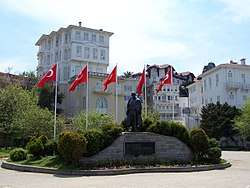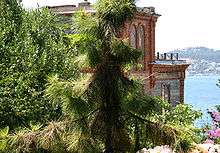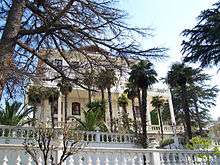Büyükada
Büyükada (Greek: Πρίγκηπος or Πρίγκιπος, rendered Prinkipos or Prinkipo) is the largest of the nine so-called Princes' Islands in the Sea of Marmara, near Istanbul, with an area of about 2 square miles (5 square kilometres). It is officially a neighbourhood in the Adalar (Islands) district of Istanbul Province, Turkey.
Büyükada | |
|---|---|
 One of the main squares of the island, with the statue of Mustafa Kemal Atatürk. | |
 Büyükada | |
| Coordinates: 40°51′28″N 29°07′12″E | |
| Country | |
| Region | Marmara |
| Province | Istanbul |
| District | Adalar |
| Area | |
| • Total | 5.4 km2 (2.1 sq mi) |
| Population (2010) | |
| • Total | 7,127 |
| • Density | 1,300/km2 (3,400/sq mi) |
| Time zone | UTC+2 (EET) |
| • Summer (DST) | UTC+3 (EEST) |
| Postal code | 34970 |
| Area code | 0-216 |
Name
The island's name means "Big Island" in Turkish. Alternative Greek names are Πρίγκηψ or Πρίγκιψ meaning "Prince" or "Foremost".
Geography
Büyükada consists of two peaks. The one nearest to the ferry landing, İsa Tepesi (meaning Jesus Hill in Turkish), formerly Hristos (Χριστός, the Greek name for Jesus Christ), is topped by the former Greek orphanage, a huge wooden building now in decay. In the valley between the two hills sit the church and monastery of Agios Nikolaos and a former fairground called Luna Park.
History

Byzantine Emperor Justin II had built a palace and monastery on Büyükada in C.E. 569.[1] A convent on Büyükada was the place of exile for the Byzantine empresses Irene, Euphrosyne, Theophano, Zoe and Anna Dalassena.
There are several historical buildings on Büyükada, such as the Hagia Yorgi Greek Orthodox Church and Monastery dating back to the 6th century, the Agios Dimitrios Church, and the Hamidiye Mosque built by Abdul Hamid II. The pier was constructed and designed by Armenian architect Mihran Azaryan.[2]
Princess Fahrelnissa Zeid was born in 1901 on the island.
After his deportation from the Soviet Union in February 1929, Leon Trotsky was moved to Büyükada (aka Prinkipo) in April 1929, where he lived until July 1933. While on Prinkipo, Trotsky stayed at a house called the Yanaros mansion.
For the first half of the 20th century, the island was popular among prosperous Turks, Greeks, Jews and Armenians.[1]
Today

The population of the island today is about 7,127 people.[1] As on the other eight islands, motorized vehicles – except service vehicles – are forbidden so residents and visitors ride bicycles or more commonly take a horse and carriage to travel around the island.[3]

Visitors can take the 'small tour' of the island by a phaeton, leading to the point from where it is a strenuous climb to Agia Yorgi (St. George, in Greek Άγιος Γεώργιος), a tiny hilltop church with a magnificent panoramic view, and a café in its garden that serves wine, chips and sausage sandwiches, this being a part of the "classic" Agia Yorgi experience.
Ferries and ships depart from Bostancı, Kartal and Maltepe on the Asian side, and from Kabataş on the European side, to Büyükada.
The conditions in which the horses on the island live and the lack of a treatment centre for horses on the island has been criticised by animal rights groups. According to official figures, 400 horses die each year, although activists consider this to be an underestimate, and claim that the lifespans of the horses on the islands are greatly reduced.[4][5]
Places of interest
Büyükada has many historic churches, monasteries and mansions that tourists can visit. The main churches in Buyukada are the Greek Orthodox Churches of Panagia, and Hagios Demetrios, Franciscan Church of San Pacifico and the Armenian Church of the Surp Astvadzadzin Verapolium. The Greek Orthodox Hagios Georgios Koudonas and Sotiros Christou are the two monasteries available on the island.
The island has a large number of historic mansions however the most popular ones are: Con Pasa, Yelkencizade, Fabiato and Mizzi Mansions.[6]
In addition, on the island there is the Prinkipo Greek Orthodox Orphanage, which is the largest wooden construction in Europe and second largest in the world.[7]
- Aerial view of the island
 A typical Ottoman era mansion in Büyükada
A typical Ottoman era mansion in Büyükada A typical Ottoman era mansion in Büyükada
A typical Ottoman era mansion in Büyükada Ottoman era houses in the streets of Büyükada
Ottoman era houses in the streets of Büyükada- Ottoman era houses in the streets of Büyükada
References
- Liesl Schillinger (July 8, 2011). "A Turkish Idyll Lost in Time". New York Times.
- "Büyükada Pier". Buyukada Island Travel Guide. Archived from the original on 1 October 2011. Retrieved 8 October 2011.
Today’s masonry structure constructed in a place of former wooden pier, built at Büyükada in 1899, was designed by Mihran Azaryan.
- Bilgen-Reinart, Üstün. Porcelain Moon and Pomegranates: A Woman's Trek Through Turkey. p. 105.
- "Atların Ömrü 20 Yıl, Faytonda Çalıştırılanların 2 Yıl". Bianet. Retrieved 5 May 2018.
- Anger sparked again after horse on Istanbul’s Princes’ Islands collapses
- Buyukada Istanbul
- Greek Orthodox orphanage, Europe’s largest wooden building, awaits salvation off Istanbul
External links
- Büyükada at Istanbul Metropolitan Municipality website
| Wikimedia Commons has media related to Büyükada. |
- Büyük Ada Travel Notes (in Turkish)